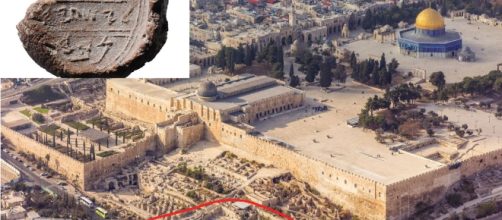Although we are bound by faith to believe the existence of a religion, archaeological discoveries do help in strengthening rationale minds seeking answers to questions against it. Now proof of the existence of Isaiah, one of the most significant prophets of the Christian Bible may have been discovered in Jerusalem.
Archaeologists of the Hebrew University led by Dr Eilat Mazaar have found a 2700-year-old clay Seal bearing the impression which they feel reads “the property of Isaiah the prophet”. The seal impression dating back to the 8th century BCE may have been made by Isaiah himself and was excavated from the remains of the First Temple in the vicinity of Jerusalem’s Temple Mount.
What leads researchers to believe the seal belonged to Isaiah?
The seal also called a Bulla was found during a renewed session of excavations at the Ophel beneath the southern wall of the Temple Mount. The oval-shaped Bulla was discovered partially intact but the writing on the seal is clear and legible. The inscription as translated by Dr Mazaar reads l’Yesha’yah[u] (belonging to Isaiah). The line below it contains the partial word NVY which could presumably be a spelling of the word ‘prophet’.
If the seal had not been damaged, it would have then been known if the last letter was indeed the Hebrew letter “aleph” that forms the last part of the Hebrew spelling of “prophet” (Nun-beit-yod-aleph.) It would then have been almost certain that the seal belonged to Isaiah.
The details of the phenomenal discovery were published in the March-June issue of the Biblical Archaeology Review.
Evidence points favourably to the seal belonging to Isaiah
The clay impression seal also bears the image of a grazing doe which is a symbol of blessings and protection and common to Judah in Jerusalem. If the seal does turn out to be the property of Isaiah, it would be the first archaeology evidence of the biblical prophet who also prophesied the coming of Jesus Christ (ex: Isaiah 7:4, 9:7 among many). What is even more interesting to note is that the seal or Bullah of King Hezekiah of Judah was found in the same area in 2015. Isaiah served as an advisor to this very same King who ruled Israel between 727-698 BCE.
According to the Bible, Isaiah influenced the king to fight against the invading Assyrian army who had besieged Jerusalem in 701 BC. They had even captured Northern Israel when Isaiah motivated the king not to surrender saying that God would help him by preventing Jerusalem’s capture. Hezekiah was successful in fighting off the Assyrians, ending the siege of the Holy City.
Skepticism over the discovery but Dr Mazaar feels otherwise
There is skepticism from various quarters of the scientific fraternity questioning if the seal is indeed that of the prophet Isaiah. Israeli Epigrapher Haggai Misgav has voiced his opinion on Facebook saying the absence of the complete inscription made it highly unlikely that the seal did indeed belong to Isiah.
Dr Mazaar, on the other hand, provided some room in her published research for doubts on the find but in the same breath was highly optimistic of the discovery.
Dr Mazaar felt that regardless of the Isaiah seal belonging to the prophet or not, it was still a “fantastic and unique discovery”.The research also provided insight into the close proximity Isaiah shared as an advisor to King Hezekiah in regards to his time as well as the influence over future events.


